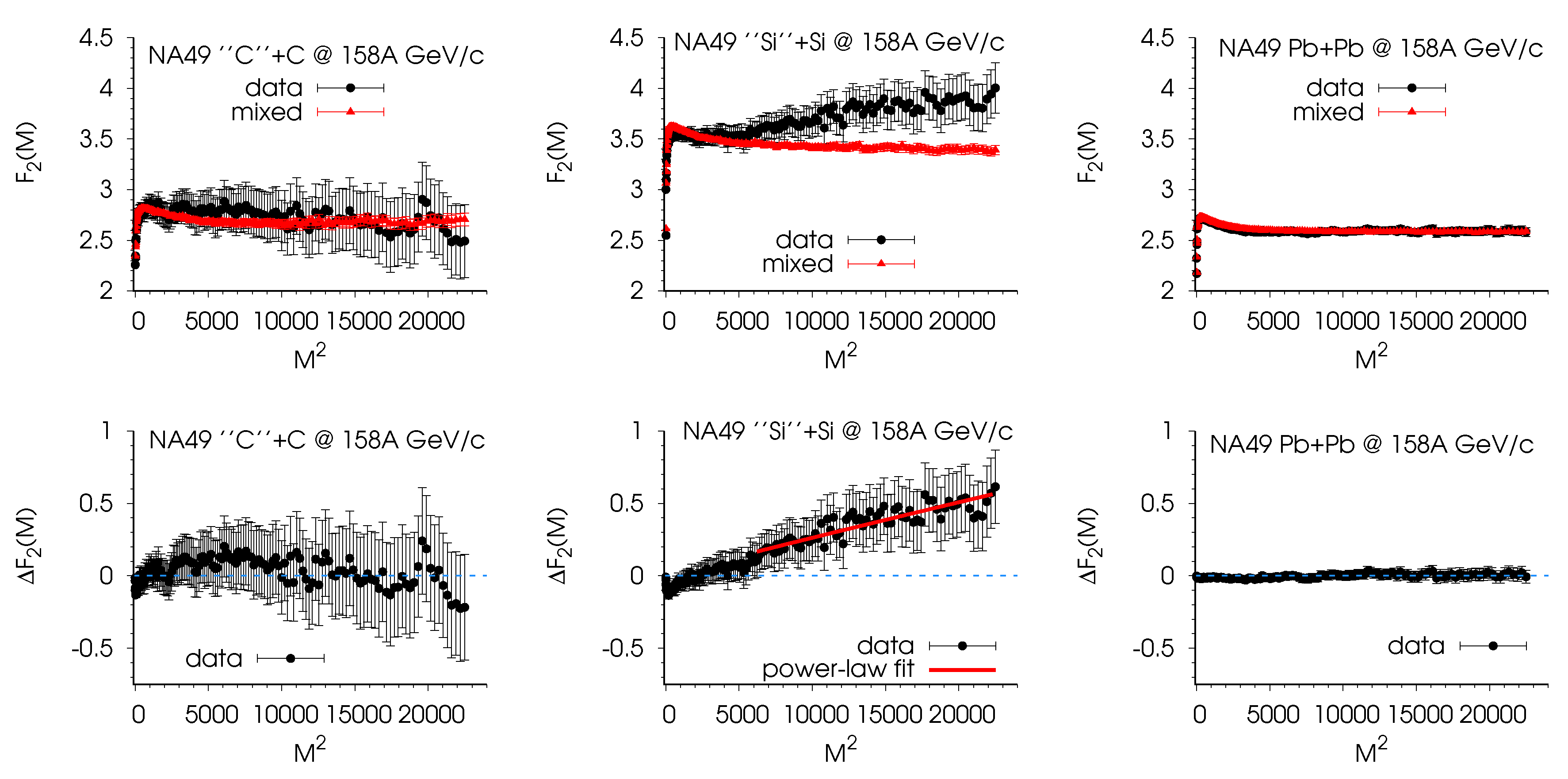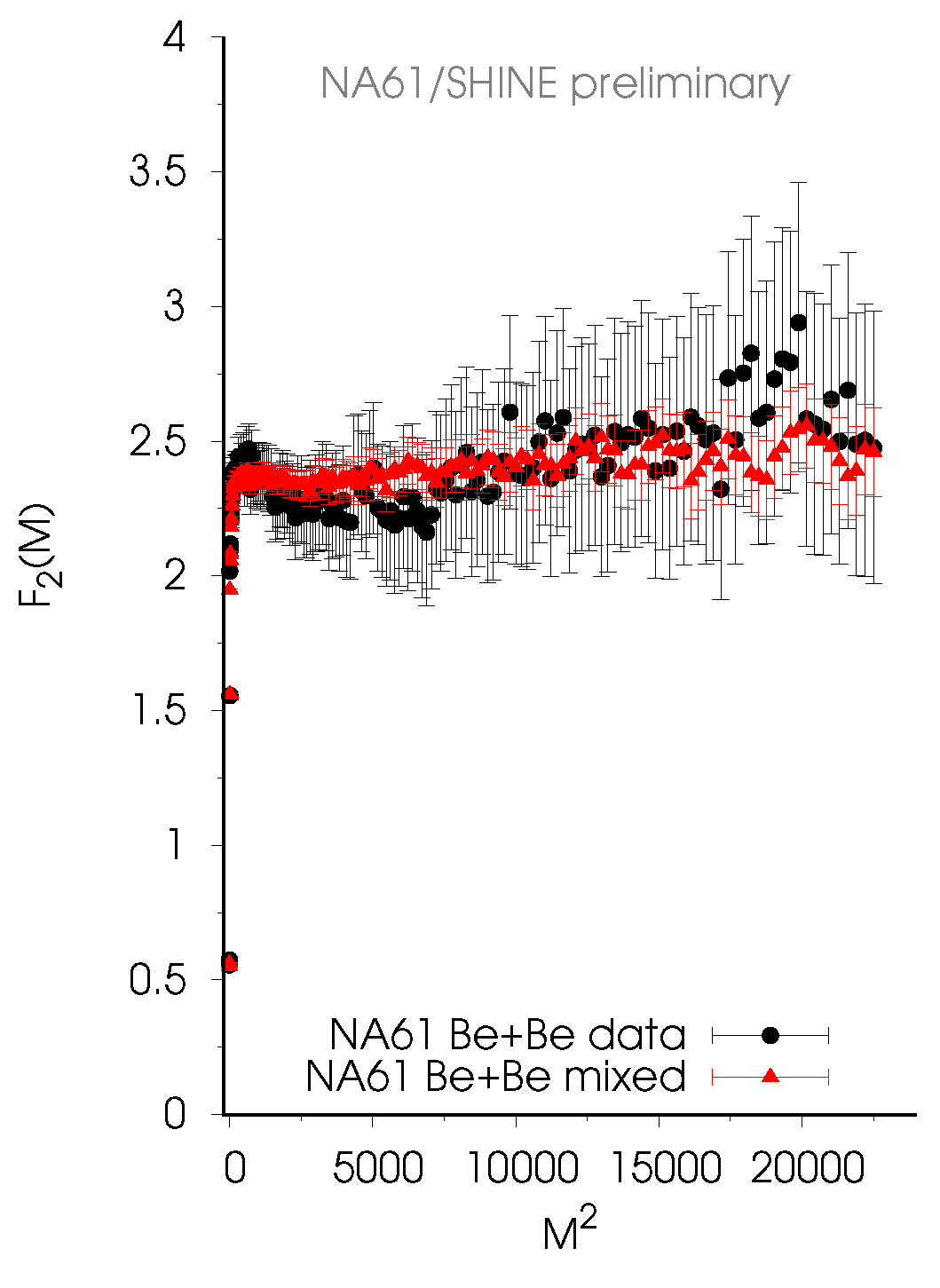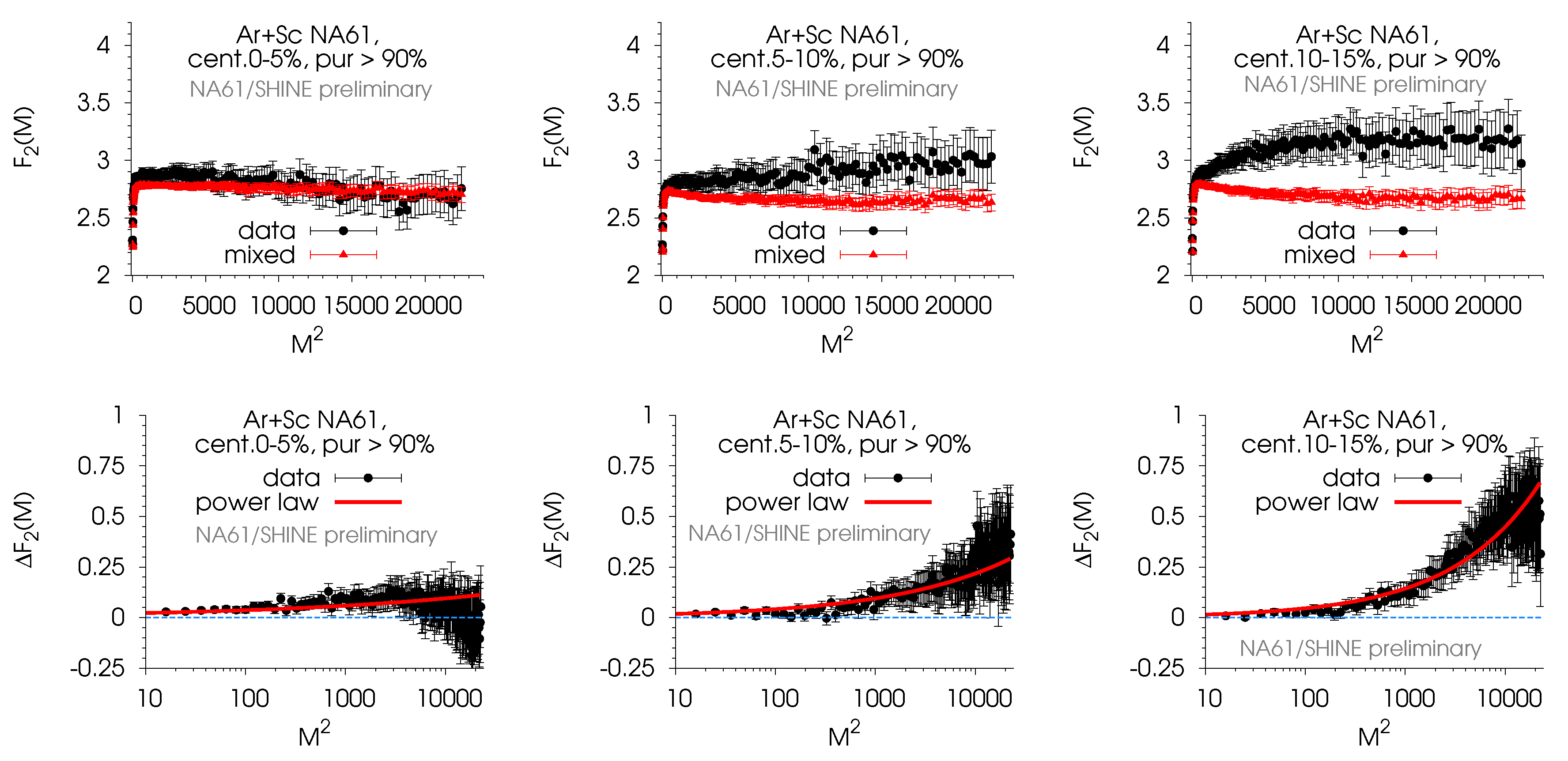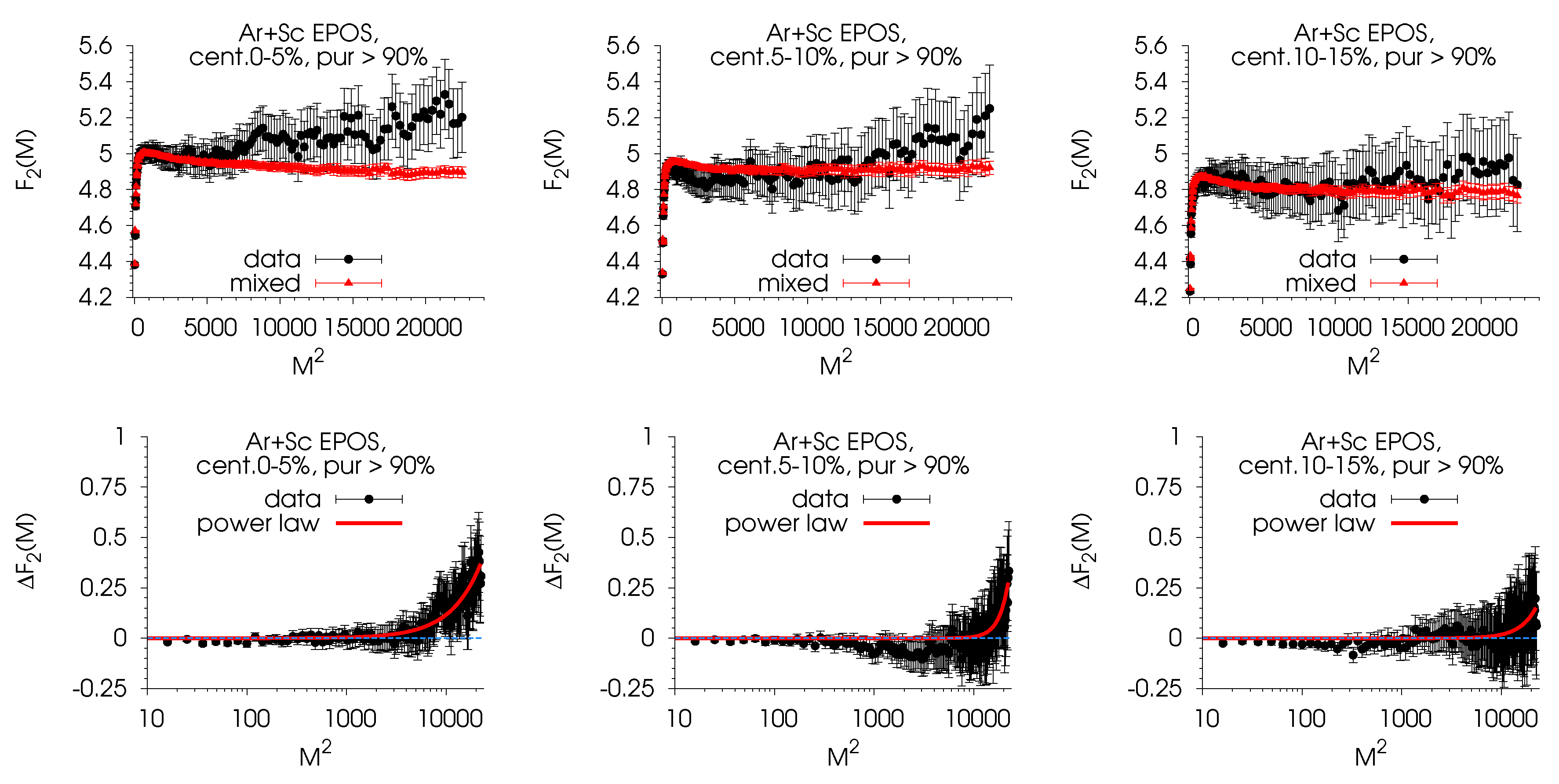Highlights from NA61/SHINE: Proton Intermittency Analysis
Abstract
:1. Introduction
2. Method of Analysis
3. Results
4. Discussion
Author Contributions
Funding
Conflicts of Interest
References
- Grebieszkow, K. [NA49 Collaboration]. Search for the critical point of strongly interacting matter in NA49. Nucl. Phys. A 2009, 830, 547c–550c. [Google Scholar] [CrossRef]
- Anticic, T.; Baatar, B.; Bartke, J.; Beck, H.; Betev, L.; Białkowska, H.; Blume, C.; Boimska, B.; Book, J.; Botje, M.; et al. [NA49 Collaboration]. Measurement of event-by-event transverse momentum and multiplicity fluctuations using strongly intensive measures Δ[PT,N] and Σ[PT,N] in nucleus-nucleus collisions at the CERN Super Proton Synchrotron. Phys. Rev. C 2015, 92, 044905. [Google Scholar] [CrossRef]
- Asakawa, M.; Yazaki, K. Chiral restoration at finite density and temperature. Nucl. Phys. A 1989, 504, 668–684. [Google Scholar]
- Barducci, A.; Casalbuoni, R.; De Curtis, S.; Gatto, R.; Pettini, G. Chiral symmetry breaking in QCD at finite temperature and density. Phys. Lett. B 1989, 231, 463–470. [Google Scholar] [CrossRef]
- Bialas, A.; Peschanski, R.B. Moments of rapidity distributions as a measure of short-range fluctuations in high-energy collisions. Nucl. Phys. B 1986, 273, 703–718. [Google Scholar] [CrossRef]
- Bowman, E.S.; Kapusta, J.I. Critical points in the linear σ model with quarks. Phys. Rev. C 2009, 79, 015202. [Google Scholar] [CrossRef]
- Stephanov, M.A. QCD Phase Diagram and the Critical Point. Prog. Theor. Phys. Suppl. 2004, 153, 139–156. [Google Scholar] [CrossRef]
- Abgrall, N.; Andreeva, O.; Aduszkiewicz, A.; Ali, Y.; Anticic, T.; Antoniou, N.; Baatar, B.; Bay, F.; Blondel, A.; Blumer, J.; et al. [NA61 Collaboration]. NA61/SHINE facility at the CERN SPS: Beams and detector system. J. Instrum. 2014, 9, P06005. [Google Scholar] [CrossRef]
- Gazdzicki, M. for the [NA49-future Collaboration]. A new SPS programme. arXiv 2006, arXiv:nucl-ex/0612007. [Google Scholar]
- Gazdzicki, M.; Seyboth, P. Search for critical behavior of strongly interacting matter at the CERN Super Proton Synchrotron. Acta Phys. Pol. B 2016, 47, 1201. [Google Scholar] [CrossRef]
- Davis, N. Recent results from proton intermittency analysis in nucleus-nucleus collisions from NA61/SHINE at CERN SPS. In Proceedings of the CPOD 2018, Corfu Island, Greece, 24–28 September 2018. [Google Scholar]
- Alt, C.; Anticic, T.; Baatar, B.; Barna, D.; Bartke, J.; Betev, L.; Bialkowska, H.; Blume, C.; Boimska, B.; Botje, M.; et al. Centrality and system size dependence of multiplicity fluctuations in nuclear collisions at 158A GeV. Phys. Rev. C 2007, 75, 064904. [Google Scholar] [CrossRef]
- Alt, C.; Anticic, T.; Baatar, B.; Barna, D.; Bartke, J.; Betev, L.; Białkowska, H.; Blume, C.; Boimska, B.; Botje, M.; et al. Energy dependence of multiplicity fluctuations in heavy ion collisions at 20A to 158A GeV. Phys. Rev. C 2008, 78, 034914. [Google Scholar] [CrossRef]
- Adamczyk, L.; Adkins, J.K.; Agakishiev, G.; Aggarwal, M.M.; Ahammed, Z.; Alekseev, I.; Alford, J.; Anson, C.D.; Aparin, A.; Arkhipkin, D.; et al. [STAR Collaboration]. Energy Dependence of Moments of Net-Proton Multiplicity Distributions at RHIC. Phys. Rev. Lett. 2014, 112, 032302. [Google Scholar] [CrossRef]
- Anticic, T.; Baatar, B.; Barna, D.; Bartke, J.; Behler, M.; Betev, L.; Bialkowska, H.; Billmeier, A.; Blume, C.; Boimska, B.; et al. Transverse momentum fluctuations in nuclear collisions at 158A GeV. Phys. Rev. C 2004, 70, 034902. [Google Scholar] [CrossRef]
- Anticic, T.; Baatar, B.; Barna, D.; Bartke, J.; Betev, L.; Białkowska, H.; Blume, C.; Boimska, B.; Botje, M.; Bunčić, P.; et al. [NA49 Collaboration]. Energy dependence of transverse momentum fluctuations in Pb+Pb collisions at the CERN Super Proton Synchrotron (SPS) at 20A to 158A GeV. Phys. Rev. C 2009, 79, 044904. [Google Scholar] [CrossRef]
- Antoniou, N.G.; Contoyiannis, Y.F.; Diakonos, F.K.; Karanikas, A.I.; Ktorides, C.N. Pion production from a critical QCD phase. Nucl. Phys. A 2001, 693, 799–824. [Google Scholar] [CrossRef]
- Hatta, Y.; Stephanov, M.A. Proton-Number Fluctuation as a Signal of the QCD Critical End Point. Phys. Rev. Lett. 2003, 91, 102003. [Google Scholar] [CrossRef]
- Antoniou, N.G.; Diakonos, F.K.; Kapoyannis, A.S.; Kousouris, K.S. Critical Opalescence in Baryonic QCD Matter. Phys. Rev. Lett. 2006, 97, 032002. [Google Scholar] [CrossRef]
- Antoniou, N.G.; Davis, N.; Diakonos, F.K. Fractality in momentum space: A signal of criticality in nuclear collisions. Phys. Rev. C 2016, 93, 014908. [Google Scholar] [CrossRef]
- De Wolf, E.A.; Dremin, I.M.; Kittel, W. Scaling laws for density correlations and fluctuations in multiparticle dynamics. Phys. Rep. 1996, 270, 1–141. [Google Scholar] [CrossRef]
- Vicsek, T. Fractal Growth Phenomena; World Scientific: Singapore, 1989; ISBN 9971-50-830-3. [Google Scholar]
- Anticic, T.; Baatar, B.; Bartke, J.; Beck, H.; Betev, L.; Białkowska, H.; Blume, C.; Bogusz, M.; Boimska, B.; Book, J.; et al. Critical fluctuations of the proton density in A+A collisions at 158A GeV. Eur. Phys. J. C 2015, 75, 587. [Google Scholar] [CrossRef]
- Werner, K.; Pierog, T.; Liu, F.M. Parton ladder splitting and the rapidity dependence of transverse momentum spectra in deuteron-gold collisions at the BNL Relativistic Heavy Ion Collider. Phys. Rev. C 2006, 74, 044902. [Google Scholar] [CrossRef]
- Davis, N.; Antoniou, N.; Diakonos, F.K. Search for the critical point of strongly interacting matter through power-law fluctuations of the proton density in NA61/SHINE. In Proceedings of the CPOD 2017, Stony Brook, NY, USA, 7–11 August 2017. [Google Scholar]
- Anticic, T.; Baatar, B.; Barna, D.; Bartke, J.; Beck, H.; Betev, L.; Białkowska, H.; Blume, C.; Bogusz, M.; Boimska, B.; et al. K★(892)0 and (892)0 production in central Pb+Pb, Si+Si, C+C, and inelastic p+p collisions at 158A GeV. Phys. Rev. C 2011, 84, 064909. [Google Scholar] [CrossRef]
- Csorgo, T. Correlation Probes of a QCD Critical Point. arXiv 2008, arXiv:0903.0669. [Google Scholar]
- Diakonos, F.K.; Antoniou, N.G.; Mavromanolakis, G. Searching for the QCD critical point in nuclear collisions. arXiv 2006, arXiv:1701.02105. [Google Scholar]
- Wosiek, J. Intermittency in the Ising Systems. Acta Phys. Pol. B 1988, 19, 863. Available online: http://www.actaphys.uj.edu.pl/fulltextseries=Regvol=19page=863 (accessed on 30 April 2019).
- Bialas, A.; Hwa, R.C. Intermittency parameters as a possible signal for quark-gluon plasma formation. Phys. Lett. B 1991, 253, 436–438. [Google Scholar] [CrossRef]
- Metzger, W.J. Estimating the Uncertainties of Factorial Moments. HEN-455. 2004. Available online: https://repository.ubn.ru.nl/bitstream/handle/2066/60397/60397.pdf (accessed on 30 April 2019).
- Efron, B. Bootstrap Methods: Another Look at the Jackknife. Ann. Stat. 1979, 7, 1–26. [Google Scholar] [CrossRef]
- Hesterberg, T.; Moore, D.S.; Monaghan, S.; Clipson, A.; Epstein, R. Bootstrap Method and Permutation Tests; W. H. Freeman & Co.: New York, NY, USA, 2003; ISBN 0716757265. [Google Scholar]
- Michael, C. Fitting correlated data. Phys. Rev. D 1994, 49, 2616–2619. [Google Scholar] [CrossRef]
- Koonin, S.E. Proton pictures of high-energy nuclear collisions. Phys. Let. B 1977, 70, 43–47. [Google Scholar] [CrossRef]
- NA61/SHINE PSD Acceptance Map. Available online: https://edms.cern.ch/document/1867336/1 (accessed on 30 April 2019).
- Antoniou, N.G.; Diakonos, F.K.; Maintas, X.N.; Tsagkarakis, C.E. Locating the QCD critical endpoint through finite-size scaling. Phys. Rev. D 2018, 97, 034015. [Google Scholar] [CrossRef]




© 2019 by the authors. Licensee MDPI, Basel, Switzerland. This article is an open access article distributed under the terms and conditions of the Creative Commons Attribution (CC BY) license (http://creativecommons.org/licenses/by/4.0/).
Share and Cite
Prokhorova, D.; Davis, N. Highlights from NA61/SHINE: Proton Intermittency Analysis. Universe 2019, 5, 103. https://doi.org/10.3390/universe5050103
Prokhorova D, Davis N. Highlights from NA61/SHINE: Proton Intermittency Analysis. Universe. 2019; 5(5):103. https://doi.org/10.3390/universe5050103
Chicago/Turabian StyleProkhorova, Daria, and Nikolaos Davis. 2019. "Highlights from NA61/SHINE: Proton Intermittency Analysis" Universe 5, no. 5: 103. https://doi.org/10.3390/universe5050103
APA StyleProkhorova, D., & Davis, N. (2019). Highlights from NA61/SHINE: Proton Intermittency Analysis. Universe, 5(5), 103. https://doi.org/10.3390/universe5050103




